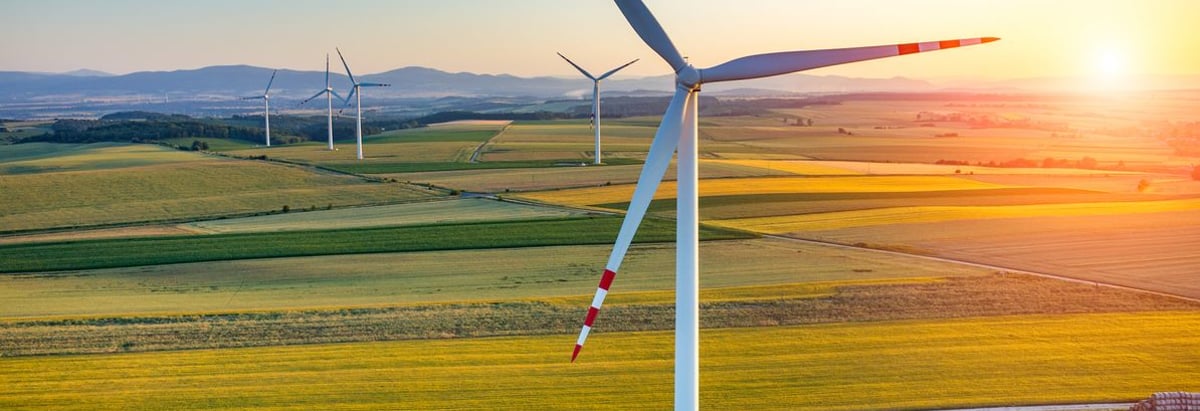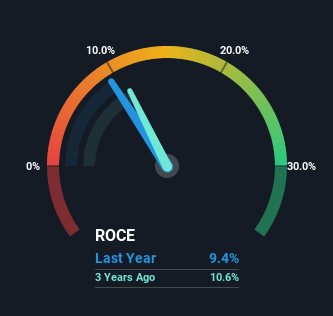- New Zealand
- /
- Renewable Energy
- /
- NZSE:NWF
NZ Windfarms (NZSE:NWF) Might Have The Makings Of A Multi-Bagger

What trends should we look for it we want to identify stocks that can multiply in value over the long term? In a perfect world, we'd like to see a company investing more capital into its business and ideally the returns earned from that capital are also increasing. If you see this, it typically means it's a company with a great business model and plenty of profitable reinvestment opportunities. Speaking of which, we noticed some great changes in NZ Windfarms' (NZSE:NWF) returns on capital, so let's have a look.
What Is Return On Capital Employed (ROCE)?
For those who don't know, ROCE is a measure of a company's yearly pre-tax profit (its return), relative to the capital employed in the business. To calculate this metric for NZ Windfarms, this is the formula:
Return on Capital Employed = Earnings Before Interest and Tax (EBIT) ÷ (Total Assets - Current Liabilities)
0.094 = NZ$4.6m ÷ (NZ$55m - NZ$6.5m) (Based on the trailing twelve months to June 2022).
Therefore, NZ Windfarms has an ROCE of 9.4%. On its own that's a low return, but compared to the average of 2.3% generated by the Renewable Energy industry, it's much better.
View our latest analysis for NZ Windfarms

While the past is not representative of the future, it can be helpful to know how a company has performed historically, which is why we have this chart above. If you're interested in investigating NZ Windfarms' past further, check out this free graph of past earnings, revenue and cash flow.
What Can We Tell From NZ Windfarms' ROCE Trend?
We're delighted to see that NZ Windfarms is reaping rewards from its investments and has now broken into profitability. The company was generating losses five years ago, but now it's turned around, earning 9.4% which is no doubt a relief for some early shareholders. In regards to capital employed, NZ Windfarms is using 30% less capital than it was five years ago, which on the surface, can indicate that the business has become more efficient at generating these returns. The reduction could indicate that the company is selling some assets, and considering returns are up, they appear to be selling the right ones.
What We Can Learn From NZ Windfarms' ROCE
From what we've seen above, NZ Windfarms has managed to increase it's returns on capital all the while reducing it's capital base. Since the stock has only returned 30% to shareholders over the last five years, the promising fundamentals may not be recognized yet by investors. So with that in mind, we think the stock deserves further research.
On a separate note, we've found 4 warning signs for NZ Windfarms you'll probably want to know about.
For those who like to invest in solid companies, check out this free list of companies with solid balance sheets and high returns on equity.
Valuation is complex, but we're here to simplify it.
Discover if NZ Windfarms might be undervalued or overvalued with our detailed analysis, featuring fair value estimates, potential risks, dividends, insider trades, and its financial condition.
Access Free AnalysisHave feedback on this article? Concerned about the content? Get in touch with us directly. Alternatively, email editorial-team (at) simplywallst.com.
This article by Simply Wall St is general in nature. We provide commentary based on historical data and analyst forecasts only using an unbiased methodology and our articles are not intended to be financial advice. It does not constitute a recommendation to buy or sell any stock, and does not take account of your objectives, or your financial situation. We aim to bring you long-term focused analysis driven by fundamental data. Note that our analysis may not factor in the latest price-sensitive company announcements or qualitative material. Simply Wall St has no position in any stocks mentioned.
About NZSE:NWF
NZ Windfarms
Generates and sells renewable electricity to the national grid in New Zealand.
Flawless balance sheet and slightly overvalued.
Market Insights
Community Narratives




